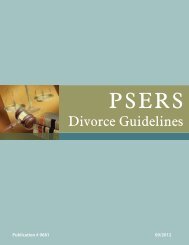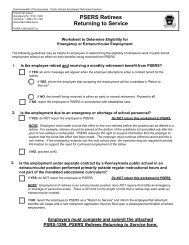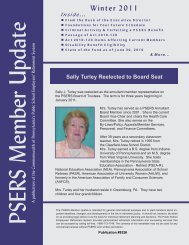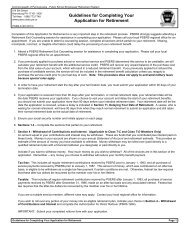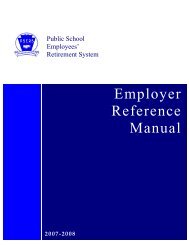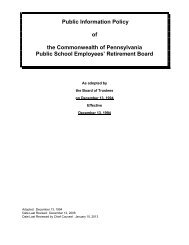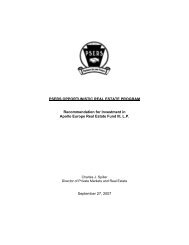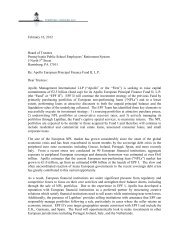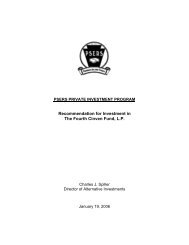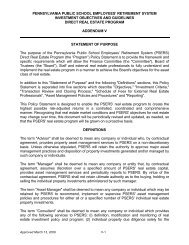Fiscal year Ended June 30, 2007 - psers
Fiscal year Ended June 30, 2007 - psers
Fiscal year Ended June 30, 2007 - psers
You also want an ePaper? Increase the reach of your titles
YUMPU automatically turns print PDFs into web optimized ePapers that Google loves.
EXHIBIT VIII<br />
Page 52<br />
GLOSSARY<br />
Accrued Liability<br />
Accrued Service<br />
Actuarial Assumptions<br />
Actuarial Cost Method<br />
Actuarial Equivalent<br />
Actuarial Value of Assets<br />
Amortization<br />
Experience Gain (Loss)<br />
Normal Cost<br />
The difference between (a) the present value of future plan<br />
benefits, and (b) the present value of future normal cost. It is<br />
the portion of the present value of future plan benefits<br />
attributable to service accrued as of the valuation date.<br />
Sometimes referred to as “actuarial accrued liability.”<br />
The service credited under the plan that was rendered before the<br />
date of the actuarial valuation.<br />
Estimates of future plan experience with respect to rates of<br />
mortality, disability, turnover, retirement, rate or rates of<br />
investment income and salary increases. Decrement<br />
assumptions (rates of mortality, disability, turnover and<br />
retirement) are generally based on past experience, often<br />
modified for projected changes in conditions. Economic<br />
assumptions (salary increases and investment income) consist<br />
of an underlying rate in an inflation-free environment plus a<br />
provision for a long-term average rate of inflation.<br />
A mathematical budgeting procedure for allocating the dollar<br />
amount of the “present value of future plan benefits” between<br />
the present value of future normal cost and the accrued liability.<br />
Sometimes referred to as the “actuarial funding method.”<br />
A series of payments is called an actuarial equivalent of another<br />
series of payments if the two series have the same actuarial<br />
present value.<br />
The value of current plan assets recognized for valuation<br />
purposes. Based on a smoothed market value that recognizes<br />
investment gains and losses over a period of three <strong>year</strong>s.<br />
Paying off an interest-bearing liability by means of periodic<br />
payments of interest and principal, as opposed to paying it off<br />
with a lump sum payment.<br />
A measure of the difference between actual experience and that<br />
expected based upon a set of actuarial assumptions during the<br />
period between two actuarial valuation dates, in accordance<br />
with the actuarial cost method being used.<br />
The annual cost assumed, under the actuarial funding method,<br />
for current and subsequent plan <strong>year</strong>s. Sometimes referred to as<br />
“current service cost.”<br />
THE PUBLIC SCHOOL EMPLOYEES’<br />
RETIREMENT SYSTEM OF PENNSYLVANIA<br />
BUCK CONSULTANTS




